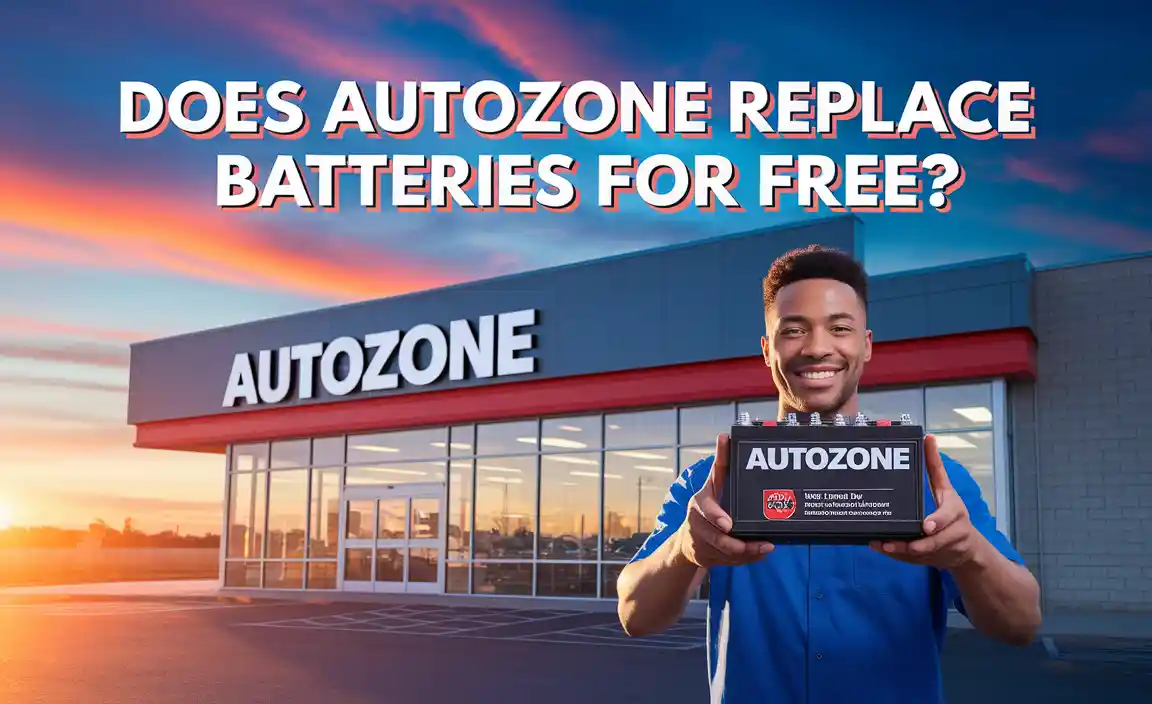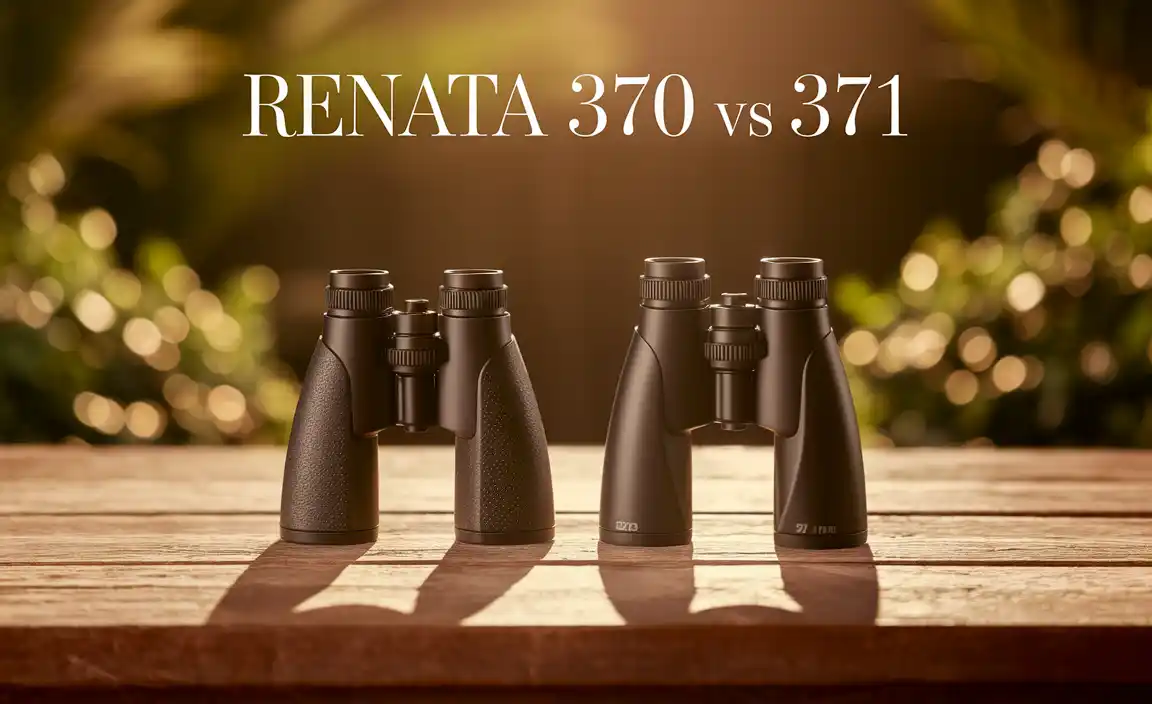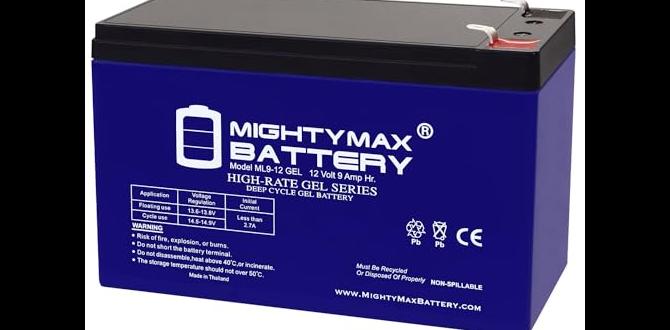Quick Summary: Looking for a cheap stop-start battery with the longest life? Choose an AGM battery specifically designed for start-stop systems. These powerhouses offer superior durability and recharge capability, ensuring lasting performance even with frequent engine restarts, making them a cost-effective, long-term investment.
Is your car’s auto start-stop system acting up, or are you simply curious about keeping your vehicle running smoothly without breaking the bank? Many drivers worry about the cost and complexity of batteries, especially for modern cars with stop-start technology. These systems put extra strain on batteries, meaning a standard one just won’t cut it. But don’t worry, finding a durable battery that’s also budget-friendly is more achievable than you might think. We’ll walk through everything you need to know to select and care for a battery that lasts. You’ll be feeling more confident about your car’s power needs in no time!
Understanding Stop-Start Batteries: The Basics
Modern cars are increasingly equipped with “stop-start” technology. This smart feature automatically shuts off the engine when you’re stopped (like at traffic lights or in slow-moving traffic) and restarts it instantly when you release the brake or press the clutch. It’s designed to save fuel and reduce emissions, which is great for your wallet and the environment. However, this constant starting and stopping puts a lot more demand on your car’s battery than traditional driving.
Think about it: a regular battery might only start your car once or twice a day. A stop-start system battery can be asked to start the engine dozens, sometimes hundreds, of times a day! This means the battery needs to be much more robust. It needs to handle frequent deep discharges and rapid recharges from the alternator and braking regenerative systems.
Why Standard Batteries Fail in Stop-Start Cars
Standard car batteries, often called SLI (Starting, Lighting, and Ignition) batteries, are built for one main purpose: delivering a powerful burst of energy to crank the engine over when you turn the key. Once the engine is running, the alternator takes over to power everything and recharge the battery. They aren’t designed for the repeated stress of being deeply discharged and then quickly recharged, as happens with stop-start systems.
Using a standard battery in a car with stop-start technology can lead to premature failure. It might seem like it’s working for a while, but you’ll likely experience a much shorter lifespan, potential electrical issues, and ultimately, the need for an expensive replacement sooner than you would otherwise. It’s like trying to use a lightweight sports shoe for marathon running – it just isn’t built for that kind of constant, demanding activity.
The Best Type for Stop-Start: AGM Batteries
When it comes to stop-start systems, the clear winner is the Absorbent Glass Mat (AGM) battery. These aren’t your grandpa’s old lead-acid batteries. AGM batteries are a more advanced technology designed specifically to handle the demands of modern vehicles.
Here’s why AGM batteries are essential for stop-start cars:
- Deeper Discharge Cycles: AGM batteries can be discharged much deeper than conventional batteries without suffering damage. This is crucial for stop-start systems where the battery is frequently called upon to power accessories when the engine is off and then restart the engine.
- Faster Recharging: They can accept a charge much faster. This is vital for stop-start systems, especially those with regenerative braking, which aims to capture energy during deceleration to charge the battery.
- Vibration Resistance: The electrolyte in an AGM battery is absorbed into a mat of fine glass fibers. This construction makes them more resistant to vibrations, which can be a problem in any vehicle, especially those with more complex internal components.
- Spill-Proof Design: Because the acid is absorbed, AGM batteries are sealed and spill-proof. This adds a layer of safety and allows them to be mounted in various positions (though usually, it’s best to stick to the manufacturer’s original orientation).
- Longer Lifespan: With proper care, AGM batteries generally have a longer lifespan than conventional batteries precisely because they are designed to handle the stresses of modern vehicles.
AGM vs. EFB: Another Stop-Start Option
While AGM is top-tier, you might also encounter Extended Flooded Battery (EFB) technology in some stop-start vehicles. EFB is an evolution of the traditional flooded battery, offering better performance and cycle life than standard batteries, but it’s generally considered a step below AGM.
Key Differences:
- Performance: EFB batteries are better suited for basic start-stop functions and vehicles with less complex electrical demands. AGM batteries are superior for vehicles with frequent start-stop cycles, high electrical loads (like heated seats, advanced infotainment systems), and regenerative braking.
- Durability: AGM batteries are more robust and durable, typically offering a longer service life under demanding conditions.
- Cost: EFB batteries are usually less expensive than AGM batteries.
For the “longest life” and best performance in a stop-start system, AGM is usually the recommended choice. Always check your car’s manual or consult a professional to know which type your vehicle requires.
Finding a “Cheap” Stop-Start Battery with Longest Life
The term “cheap” can be tricky when it comes to car batteries. A low upfront price might seem appealing, but if the battery doesn’t last or doesn’t perform correctly, it ends up being more expensive in the long run. The real goal is to find the best value – a battery that offers excellent longevity and reliable performance without an exorbitant price tag.
Here’s how to hunt for a good deal on a quality stop-start battery:
- Know Your Requirements: Before shopping, find out the exact specifications your car needs. This includes the battery group size, terminal type, and voltage. Your owner’s manual is the best place to find this information. If your car has stop-start, it almost certainly needs an AGM or EFB battery.
- Compare Brands and Retailers: Don’t just grab the first battery you see. Research different reputable battery brands known for their quality. Compare prices at national auto parts stores, local independent shops, and even online retailers. Keep an eye out for sales and promotions.
- Look for Long Warranties: A longer warranty is a strong indicator of a manufacturer’s confidence in their product’s durability. Look for batteries with warranties of 3 years or more specifically for AGM types designed for stop-start. A good warranty can save you money if the battery fails prematurely.
- Consider Store Brands (with caution): Many auto parts chains offer their own “house brands.” Some of these can be excellent value, offering good performance at a lower price point. However, always check reviews and warranty terms for these store brands, as quality can vary.
- Don’t Rule Out Certified Rebuilders: For a truly budget-conscious option, some areas have certified battery rebuilders. They take old batteries, test them thoroughly, and often replace internal components to bring them back to reliable working order. Some may offer a limited warranty. However, this is an advanced option and might not be suitable for all stop-start systems due to their specific demands. Always ensure they explicitly guarantee performance for stop-start applications.
Cost Breakdown: What to Expect
Prices for stop-start batteries can vary significantly. Here’s a general idea of what you might pay:
| Battery Type | Typical Price Range (USD) | Notes |
|---|---|---|
| Standard Flooded Battery | $80 – $150 | Not suitable for stop-start systems. |
| EFB Battery | $120 – $200 | Entry-level for some stop-start cars, better than standard but less robust than AGM. |
| AGM Battery | $180 – $350+ | Recommended for most stop-start vehicles. Price varies by brand, size, and warranty. |
While AGM batteries have a higher upfront cost, their extended lifespan and ability to cope with the demands of stop-start technology make them the most cost-effective option for those seeking the “longest life” and reliable performance. A cheaper battery that fails in a year will cost you more in the long run than a good AGM that lasts 4-5 years.
Extending Your Stop-Start Battery’s Life
Buying the right battery is only half the battle. Proper maintenance and good driving habits can significantly extend the life of your stop-start battery, ensuring you get the most for your money.
Regular Cleaning and Inspection
Periodically check your car battery for obvious signs of wear or damage. This is a simple but important step.
- Keep Terminals Clean: Over time, terminals can accumulate a white or bluish powdery substance (corrosion). This can impede electrical flow. You can clean them with a wire brush and a mixture of baking soda and water. Make sure the battery is disconnected before cleaning.
- Check for Damage: Inspect the battery case for any cracks, leaks, or swelling. If you see any, the battery needs immediate replacement.
- Ensure Connections are Tight: Loose battery terminal connections can cause a range of electrical problems and put extra strain on the battery. They should be snug but not so tight that they could damage the terminals.
Smart Charging Habits
While your car’s alternator is designed to charge the battery, understanding how charging works can help you make informed decisions.
- Avoid Frequent Short Trips: Short trips where the engine doesn’t run long enough to fully recharge the battery can gradually deplete its charge. If most of your driving involves very short hops, consider taking the car for a longer drive (at least 30 minutes) once a week to ensure it gets a full charge.
- Don’t Drain the Battery with Accessories: Running accessories like the radio, interior lights, or charging devices with the engine off can drain the battery. With stop-start systems, the battery already works harder, so minimizing unnecessary drains is key.
- Consider a Battery Maintainer: For cars that sit for extended periods (e.g., classic cars, seasonal vehicles), a smart battery maintainer or trickle charger designed for AGM batteries can be a worthwhile investment. These devices keep the battery topped up without overcharging. For modern cars with stop-start, a quality charger can also help recover batteries that have been slightly drained. Always choose a charger specifically designed for AGM batteries, as they have different charging profiles than standard flooded batteries. A good charger might look something like a CTEK MXS 5.0, known for its multi-stage charging.
Driving Habits and Electrical Load
Your driving style can also impact battery health.
- Manage Electrical Demand: If your car has many power-hungry accessories (GPS, multiple phone chargers, heated seats, powerful sound systems), try to use them wisely, especially when the engine might be frequently stopping and starting.
- Understand Regenerative Braking: Cars with regenerative braking capture energy during deceleration. This energy goes back into the battery. This is beneficial for stop-start systems, as it helps keep the battery charged. However, if you’re braking very gently all the time, you might capture less energy.
DIY vs. Professional Battery Replacement
Replacing a car battery can seem daunting, but many DIY enthusiasts tackle it. However, for stop-start vehicles, especially those with sophisticated battery management systems, professional installation is often recommended.
DIY Battery Replacement: What You Need to Know
If you decide to go the DIY route, proceed with extreme caution to ensure safety and prevent damage to your vehicle’s electronics.
Tools You’ll Likely Need:
- New AGM battery (correct group size and specifications)
- Safety glasses
- Gloves
- Wrench or socket set (usually 10mm and 13mm for terminals and hold-down bracket)
- Battery terminal cleaner or wire brush
- Baking soda and water solution (for cleaning terminals)
- Rag or paper towels
- Memory saver (optional, but highly recommended for modern cars to maintain car settings and computer memory)
Basic Steps (Always consult your vehicle’s manual for specific instructions):
- Park Safely: Ensure the car is on a flat surface, the parking brake is engaged, and the engine is off.
- Locate the Battery: Batteries are usually under the hood, but can sometimes be in the trunk or under a seat.
- Disconnect the Negative Terminal First: This is crucial for safety. Use your wrench to loosen and remove the black (negative, “-“) cable clamp from the battery post. Tuck it away so it cannot accidentally touch the battery terminal.
- Disconnect the Positive Terminal: Next, loosen and remove the red (positive, “+”) cable clamp. Again, tuck it away.
- Remove the Hold-Down Bracket: Batteries are secured by a bracket. Remove any nuts or bolts holding this bracket in place.
- Lift Out the Old Battery: Batteries are heavy (often 30-50 lbs). Lift carefully, keeping your back straight.
- Install the New Battery: Place the new battery in the tray, ensuring it’s oriented correctly.
- Secure the Hold-Down Bracket: Reinstall and tighten the bracket to hold the battery firmly in place.
- Connect the Positive Terminal First: Attach the red (positive, “+”) cable clamp and tighten it securely.
- Connect the Negative Terminal Last: Attach the black (negative, “-“) cable clamp and tighten it.
- Clean Up: Dispose of the old battery responsibly. Many auto parts stores offer recycling services.
Crucial Note for Stop-Start Cars: Many modern cars with stop-start systems have a battery management system (BMS) that needs to be informed when a new battery is installed, or its capacity has changed. Failure to reset or reprogram the BMS after a battery change can lead to the new battery not charging correctly, reduced lifespan, or even damage to the vehicle’s electrical system. This reprogramming often requires specialized diagnostic scan tools, which is best done by a professional mechanic. For instance, a tool like the Autel MaxiBAS or similar professional equipment is often used for this task.
When to Call a Professional
If you’re not comfortable with basic car maintenance, if your vehicle has a complex battery management system, or if you lack the specialized tools needed for BMS reset, it’s always best to have a qualified mechanic replace the battery. They have the expertise and equipment to ensure the job is done correctly and safely, preventing costly damage to your car’s sensitive electronics.
FAQ: Your Stop-Start Battery Questions Answered
Q1: How often should I replace my stop-start battery?
A: While a standard car battery might last 3-5 years, a high-quality AGM stop-start battery, with good driving habits and maintenance, can last anywhere from 4 to 7 years. However, batteries degrade over time, and performance can decrease gradually. It’s wise to have it tested annually after about 3 years of age.
Q2: Can I use a regular car battery in a stop-start car?
A: No, it’s strongly not recommended. Regular batteries are not built to handle the deep discharges and frequent restarts of a stop-start system. Using one will likely lead to premature failure and can potentially cause electrical issues.
Q3: What is the biggest factor affecting my stop-start battery life?
A: The most significant factor is the number of start-stop cycles and the depth of discharge. Frequent short trips that don’t allow the battery to fully recharge, and excessive use of electrical accessories with the engine off, will shorten its life more than anything else.
Q4: My car’s stop-start feature stopped working. Is it always the battery?
A: Not always, but it’s a very common cause. The stop-start system has many sensors and parameters it checks before disabling the engine. A battery that’s not at sufficient charge or is nearing the end of its life is a primary reason for the system to deactivate itself to prevent a no-start situation. However, other issues like a faulty sensor or problems with the engine control unit could also be to blame.
Q5: How do I know if my battery is dying?
A: Signs include slow engine cranking, dimming headlights or interior lights when the engine is off or at idle, a clicking sound when you try to start the car, warning lights on the dashboard (like a battery or check engine light), and the stop-start system failing to engage. If you notice any of these, get your battery tested immediately.
Q6: Is it okay to buy a used battery for my stop-start car?
A: It’s generally







